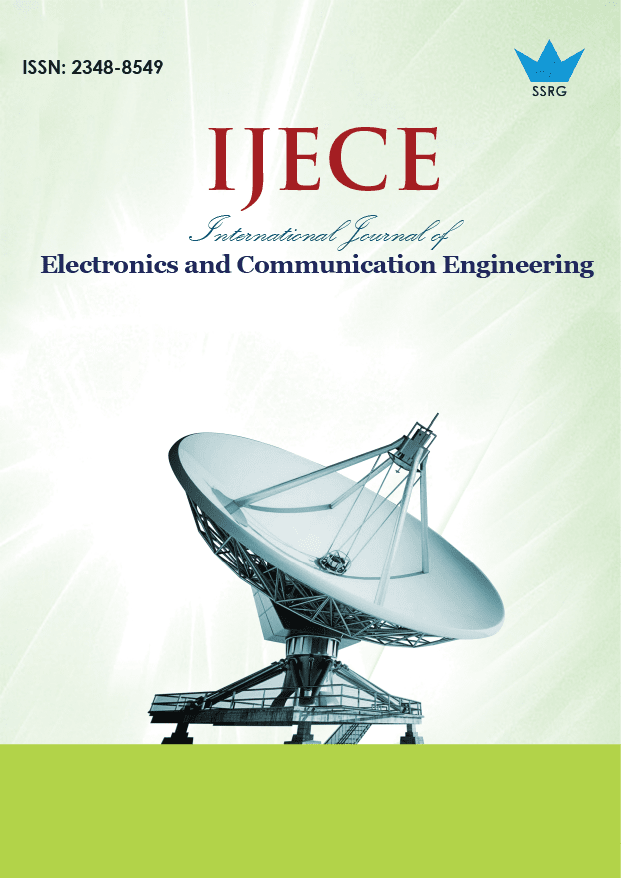Performance of DSSS-BPSK System for Even/Odd Parity Maximal Sequences

| International Journal of Electronics and Communication Engineering |
| © 2025 by SSRG - IJECE Journal |
| Volume 12 Issue 6 |
| Year of Publication : 2025 |
| Authors : M. Dileep Reddy, G. Sreenivasulu |
How to Cite?
M. Dileep Reddy, G. Sreenivasulu, "Performance of DSSS-BPSK System for Even/Odd Parity Maximal Sequences," SSRG International Journal of Electronics and Communication Engineering, vol. 12, no. 6, pp. 101-105, 2025. Crossref, https://doi.org/10.14445/23488549/IJECE-V12I6P108
Abstract:
The maximal Sequence generated from linear feedback shift registers is used as an input sequence to the Hamming Code generator, where redundant binary bits are added to the original M sequence to generate new sequences. Two sequences can be obtained from each Maximal Sequence: one by even Parity and another by odd Parity. M sequence has an Auto correlation of 2P-1 where the number of shift registers and cross-correlation value should be as low as possible; the ideal value is zero [1]. Complete analysis of maximal sequences, i.e., Number of valid taps, tap combinations and M-sequences, are presented [2]. Each maximal Sequence produces two codes (even parity sequence and odd Parity sequence). This paper aims to prove that the proposed codes have improved autocorrelation and cross-correlation and increased the number of codes... Further, the improvement in the Probability of error vs. vs. noise ratio is shown through graphs generated in matlab®
Keywords:
Autocorrelation, Cross correlation BPSK, Odd parity, Even parity, BER.
References:
[1] R. Gold, “Maximal Recursive Sequences with 3-Valued Recursive Cross-Correlation Function,” IEEE Transactions on Information Theory, vol. 14, no. 1, pp. 154-156, 1968.
[CrossRef] [Google Scholar] [Publisher Link]
[2] Zenon Syroka, Tomasz Zając, and Paweł Dubiłowicz, “Generation of Linear Maximal Length Sequences,” 2010 International Conference on Computer Information Systems and Industrial Management Applications (CISIM), Krakow, Poland, pp. 309-313, 2010.
[CrossRef] [Google Scholar] [Publisher Link]
[3] A.Y.C. Quan, “A Note on High-Speed Generation of Maximal Length Sequences,” IEEE Transactions on Computers, vol. 23, no. 2, pp. 201-203, 1974.
[CrossRef] [Google Scholar] [Publisher Link]
[4] John J. Komo et al., “Maximal Length Sequences for QPSK,” IEEE Conference on Proceedings of The Twentieth Southeastern Symposium on System Theory, Charlotte, NC, USA, pp. 332-335, 1998.
[CrossRef] [Google Scholar] [Publisher Link]
[5] R. Gold, “Optimal Binary Sequences for Spread Spectrum Multiplexing (Corresp.),” IEEE Transformation on Information Theory, vol. 13, no. 4, pp. 619-621, 1967.
[CrossRef] [Google Scholar] [Publisher Link]
[6] J.J. Komo, “Crosscorrelation of m-sequences Over Nonprime Finite Fields,” Electronics Letters, vol. 25, no. 4, 1989.
[CrossRef] [Google Scholar] [Publisher Link]
[7] R. Kohno, R. Meidan, and L.B. Milstein, “Spread Spectrum Access Methods for Wireless Communications,” IEEE Communications Magazine, vol. 33, no. 1, pp. 58-67, 1995.
[CrossRef] [Google Scholar] [Publisher Link]
[8] Esmael H. Dinan, and Bijan Jabbari, “Spreading Codes for Direct Sequence CDMA and Wideband CDMA Cellular Networks,” IEEE Communications Magazine, vol. 36, no. 9, pp. 48-54, 1998.
[CrossRef] [Google Scholar] [Publisher Link]
[9] Olanrewaju Bola Wojuola, “Cross-Correlation Index and Multiple-Access Performance of Even-Degree Gold Codes,” 2019 21st International Conference on Advanced Communication Technology (ICACT), PyeongChang, Korea (South), pp. 111-114, 2019.
[CrossRef] [Google Scholar] [Publisher Link]
[10] D.V. Sarwate, and M.B. Pursley, “Cross Correlation Properties of Pseudorandom and Related Sequences,” Proceedings of the IEEE, vol. 68, no. 5, pp. 593-619, 1980.
[CrossRef] [Google Scholar] [Publisher Link]
[11] Deepak Kedia, “Comparative Analysis of Peak Correlation Characteristics of Non-Orthogonal Spreading Codes for Wireless Systems,” International Journal of Distributed and Parallel Systems, vol. 3, no. 3, pp. 63-74, 2012.
[CrossRef] [Google Scholar] [Publisher Link]
[12] Sujit Jos et al., “Method of Generating Multiple Sets of Orthogonal Codes with Wide Choice of Spreading Factors,” IEEE Wireless Communications Letters, vol. 1, no. 5, pp. 492-495, 2012.
[CrossRef] [Google Scholar] [Publisher Link]
[13] Yan Jun, and Zhang Xiang-Li, “A New Design of Gold-Like Binary Sequences,” 2017 2nd Asia-Pacific Conference on Intelligent Robot Systems (ACIRS), Wuhan, China, pp. 118-124, 2017.
[CrossRef] [Google Scholar] [Publisher Link]
[14] S.W. Golomb, “Shift-Register Sequences and Spread-Spectrum Communications,” Proceedings of IEEE 3rd International Symposium on Spread Spectrum Techniques and Applications (ISSSTA'94), Oulu, Finland, vol. 1, pp. 14-15, 1994.
[CrossRef] [Google Scholar] [Publisher Link]
[15] Zhang Xinyu, “Analysis of M-Sequence and Gold-Sequence in CDMA System,” 2011 IEEE 3rd International Conference on Communication Software and Networks, Xi'an, China, pp. 466-468, 2011.
[CrossRef] [Google Scholar] [Publisher Link]

 10.14445/23488549/IJECE-V12I6P108
10.14445/23488549/IJECE-V12I6P108